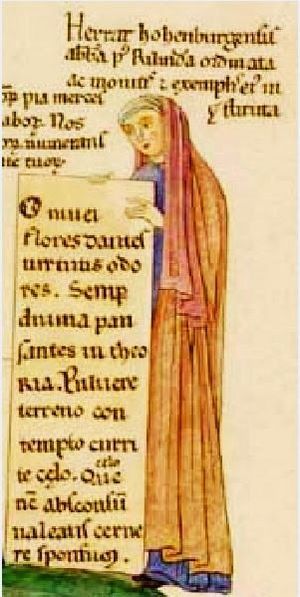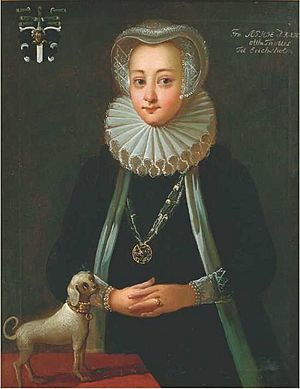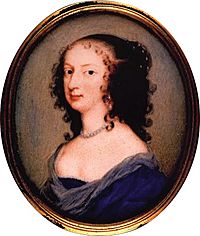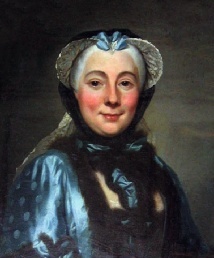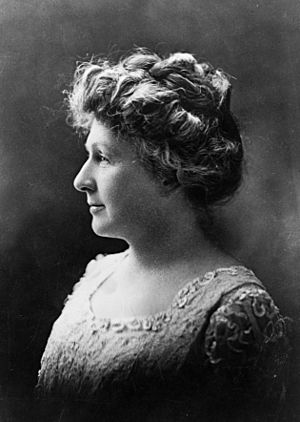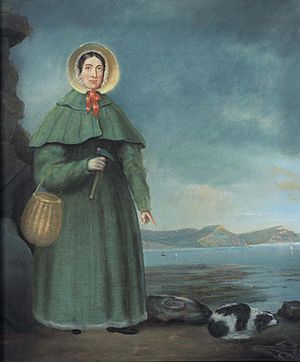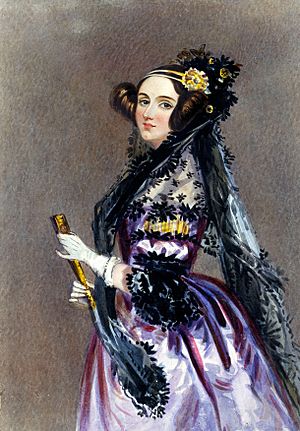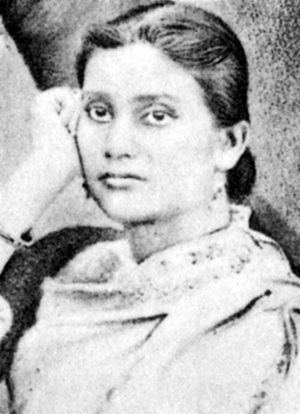List of female scientists before the 20th century facts for kids
This article is about amazing women who made important discoveries in science throughout history. For a long time, it was rare for women to work in science. This list focuses on women scientists up to the end of the 20th century.
Contents
- Ancient Times: Smart Women of the Past
- Middle Ages: Learning and Healing
- 16th Century: New Discoveries
- 17th Century: Expanding Horizons
- 18th Century: The Age of Enlightenment
- 19th Century: A Century of Progress
- Anthropology and Archaeology
- Astronomy: Stargazers
- Biology and Natural History: Studying Life
- Chemistry: Understanding Materials
- Engineering and Invention: Building and Creating
- Geology: Studying Earth
- Mathematics: Numbers and Logic
- Microbiology: Tiny Life
- Medicine: Healing and Health
- Nuclear Physics: The Atom's Secrets
- Physics: How Things Work
- Psychology: The Mind
- Science Education: Sharing Knowledge
- Sociology: Studying Society
- See also
Ancient Times: Smart Women of the Past
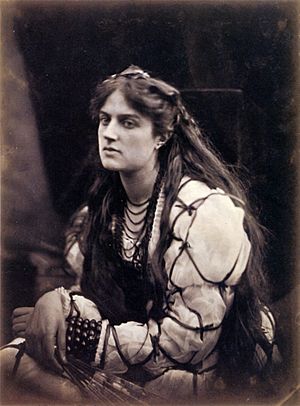
Even in ancient times, women were involved in science! They worked as doctors, astronomers, and philosophers.
- Aemilia (around 300–363 CE): A doctor from ancient Gaul and Rome.
- Aglaonike (2nd century BCE): An astronomer in Ancient Greece. She could even predict lunar eclipses!
- Agnodike (4th century BCE): The first woman doctor allowed to practice legally in Athens.
- Andromache (mid-6th century): An Egyptian doctor.
- Arete of Cyrene (5th–4th centuries BCE): A Greek philosopher who studied nature and how people should live.
- Artemisia of Caria (around 300 BCE): A botanist, meaning she studied plants.
- Aspasia the Physician (1st century CE): A Greek doctor.
- Aurelia Alexandria Zosime: An ancient Roman doctor.
- Chun Yuyan (1st century BCE): A Chinese doctor who helped women during childbirth.
- Cleopatra the Alchemist (around 3rd century CE): She wrote a book about alchemy, which was an early form of chemistry.
- Damo (6th century BCE): A Greek philosopher who studied nature.
- Diotima of Mantinea (4th century BCE): A philosopher and scientist in ancient Greece.
- Eccello of Lucania (5th or 4th centuries BCE): A Greek/Italian mathematician and natural philosopher.
- Echecratia the Philiasian (5th century BCE): A Greek/Italian mathematician and natural philosopher.
- Elephantis (1st century BCE): A Greek doctor.
- Enheduanna (around 2285–2250 BCE): A Sumerian/Akkadian astronomer and poet.
- Fabiola (died 399 CE): A Roman doctor.
- Fang (1st century BCE): A Chinese chemist.
- Favilla (2nd century): A Roman doctor.
- Gargi Vachaknavi (7th century BCE): An Indian philosopher.
- Gu Bao (4th century): A Chinese doctor.
- Hypatia (370–415 CE): A brilliant mathematician and astronomer from Egypt.
- Laïs (around 1st/2nd century BCE): A midwife, who helped women give birth.
- Lais of Corinth: An ancient Greek doctor.
- Leoparda (4th century CE): A doctor who specialized in women's health.
- Macrina (4th century CE): A Greek doctor and nun.
- Marcella (4th century CE): A Roman healer.
- Mary the Jewess (1st or 2nd century CE): An alchemist who invented important chemistry tools.
- Melissa (3rd century BCE): A Greek philosopher.
- Metrodora (around 200–400 CE): A Greek doctor and writer.
- Minucia Asste: An ancient Roman doctor.
- Myia (5th century BCE): A Greek philosopher.
- Nicerata (around 5th century): A doctor and healer.
- Occello of Lucania (4th or 5th century BCE): A Greek natural philosopher and mathematician.
- Olympias of Thebes (1st century BCE): A Greek midwife.
- Origenia (2nd century CE): A Greek healer.
- Pao Ku Ko (3rd century CE): A Chinese chemist.
- Paphnutia the Virgin (around 300): An Egyptian alchemist.
- Paula (347–404 CE): A Roman healer.
- Perictione (5th century BCE): A Greek philosopher and mother of the famous philosopher Plato.
- Panthea: An ancient Greek doctor.
- Philinna of Thessaly: An ancient Greek doctor.
- Peseshet: An Egyptian doctor from a very old dynasty.
- Pulcheria (5th century CE): A healer.
- Pythias of Assos (4th century BCE): A marine zoologist, studying sea animals.
- Restituta (1st century): An ancient Roman doctor.
- Salpe (1st century BCE): A Greek midwife.
- Sotira (1st century BCE): A Greek doctor.
- Tapputi-Belatekallim (around 2000 BCE): A Babylonian perfumer, possibly the first person to use a chemical process.
- Terentia Prima: An ancient Roman doctor.
- Theano (6th century BCE): A philosopher, mathematician, and doctor.
- Thelka: From ancient Iran.
- Theosebeia (4th century CE): A healer.
- Yi Jia (2nd century BCE): A Chinese doctor.
Middle Ages: Learning and Healing
During the Middle Ages, women continued to be involved in medicine and other fields, often in convents or through family traditions.
- Abella (14th century): An Italian doctor.
- Adelle of the Saracens (12th century): An Italian doctor.
- Adelmota of Carrara (14th century): An Italian doctor.
- Rufaida Al-Aslamia (7th century): A Muslim nurse, considered one of the first nurses in Islamic history.
- Maesta Antonia (1386–1408): A doctor from Florence, Italy.
- Ameline la Miresse (active 1313–1325): A French doctor.
- Jeanne d'Ausshure (died 1366): A French surgeon.
- Brunetta de Siena (active 15th century): An Italian-Jewish doctor.
- Hildegard of Bingen (1099–1179): A German natural philosopher, writer, and composer.
- Sibyl of Benevento: A doctor from Naples who specialized in treating the plague.
- Gentile Budrioli (died 1498): An Italian astrologer and herbalist.
- Constanza: An Italian surgeon.
- Denice (active 1292): A French barber-surgeon.
- Demud (active around 13th century): A German doctor.
- Dobrodeia of Kiev (active 1122): A Byzantine doctor.
- Dorotea Bucca (active 1390): An Italian professor of medicine.
- Constance Calenda (15th century): An Italian surgeon who specialized in eye diseases.
- Virdimura of Catania (active 1376): A Jewish-Sicilian doctor.
- Caterina of Florence (active 1400s): A doctor from Florence.
- Jeanne de Cusey (active 1438): A French barber-surgeon.
- Antonia Daniello (active 1400): A Florentine-Jewish doctor.
- Clarice di Durisio (15th century): An Italian doctor.
- Fava of Manosque (active 1322): A French-Jewish doctor.
- Jacobina Félicie (active 1322): An Italian doctor.
- Francesca, muller de Berenguer Satorra (15th century): A Catalan doctor.
- Maria Gallicia (active 1309): A licensed surgeon.
- Bellayne Gallipapa (active 1380): A Spanish-Jewish doctor from Zaragoza.
- Dolcich Gallipapa (active 1384): A Spanish-Jewish doctor from Leyda.
- Na Pla Gallipapa (active 1387): A Spanish-Jewish doctor from Zaragoza.
- Sarah de St Giles (active 1326): A French-Jewish doctor and medical teacher.
- Alessandra Giliani (active 1318): An Italian anatomist, who studied the body's structure.
- Rebecca de Guarna (active 1200): An Italian doctor.
- Magistra Hersend (active 1249–1259): A French surgeon.
- Maria Incarnata: An Italian surgeon.
- Isabiau la Mergesse (active 1292): A French-Jewish doctor.
- Floreta La-Noga (active 1374): An Aragonese doctor.
- Helvidis (active 1176): A French doctor.
- Keng Hsien-Seng (10th century): A Chinese chemist.
- Li Shao Yun (11th century): A Chinese chemist.
- Stephanie de Lyon (active 1265): A French doctor.
- Guillemette du Luys (active 1479): A French royal surgeon.
- Thomasia de Mattio: An Italian doctor.
- Margherita di Napoli (late 14th century): An eye doctor from Naples.
- Mercuriade (14th century): An Italian doctor and surgeon.
- Gilette de Narbonne (active 1300): A French doctor.
- Isabella da Ocre: A surgeon from Naples.
- Francisca da Romana: A doctor from Naples.
- Dame Péronelle (1292–1319): A French herbalist, using plants for medicine.
- Peretta Peronne (active 1411): A French surgeon.
- Lauretta Ponte da Saracena Calabria: A doctor from Naples.
- Trota of Salerno (active 1090): A famous Italian doctor.
- Marguerite Saluzzi (active 1460): A licensed herbalist doctor from Naples.
- Sara de Sancto Aegidio (active 1326): A French doctor.
- Juana Sarrovia (active 1384): A Spanish doctor from Barcelona.
- Shen Yu Hsiu (15th century): A Chinese chemist.
- Sun Pu-Eh (12th century): A Chinese chemist.
- Raymunda da Taberna: A licensed surgeon from Naples.
- Théophanie (active 1291): A French barber surgeon.
- Trotta da Toya (active 1307): A doctor from Naples.
- Polisena da Troya (active 1335): A licensed surgeon from Naples.
- Margarita da Venosa (active 1333): A licensed surgeon from Naples who studied at the University of Salerno. She even treated the king of Naples!
- Francisca di Vestis (active 1308): A doctor from Naples.
- Zhang Xiaoniang (11th century): A Chinese doctor.
16th Century: New Discoveries
The 16th century saw women contributing to pharmacy, botany, and astronomy.
- Maria Andreae (1550–1632): A German pharmacist.
- Marie de Brimeu (1550–1605): A Flemish botanist.
- Sophia Brahe (1556–1643): A Danish astronomer and chemist. She helped her brother, a famous astronomer.
- Isabella Cortese (active 1561): An Italian alchemist.
- Helena Magenbuch (1523–1597): A German pharmacist.
- Loredana Marcello (died 1572): A Venetian botanist.
- Elizabeth Moulthorne (active 1593): An English barber-surgeon.
- Tarquinia Molza (1542–1617): An Italian natural philosopher.
- Catherine de Parthenay (1554–1631): A French mathematician.
- Elinor Sneshell (active 1593): An English surgeon.
- Agatha Streicher (1520–1581): A German doctor.
- Caterina Vitale (1566–1619): A Maltese pharmacist and chemist.
- Tan Yunxian (1461–1554): A Chinese doctor.
17th Century: Expanding Horizons
In the 17th century, women explored archaeology, natural philosophy, and astronomy.
- Anna Åkerhjelm (1647–1693): A Swedish traveler and archaeologist.
- Ann Baynard (1672–1697): A British natural philosopher.
- Aphra Behn (1640–1689): A British writer who translated an astronomy book.
- Martine Bertereau (1600–active 1642): A French mineralogist, studying minerals.
- Agnes Block (1629–1704): A Dutch gardener who specialized in plants.
- Elisabeth of Bohemia, Princess Palatine (1618–1680): A German natural philosopher.
- Louise Bourgeois Boursier (1563–1636): A French obstetrician, helping with childbirth.
- Titia Brongersma (1650–1700): A Frisian archaeologist and poet.
- Margaret Cavendish (1623–1673): A natural philosopher and writer.
- Marie Crous (active 1640): A French mathematician.
- Maria Cunitz (1610–1664): A Silesian astronomer.
- Jeanne Dumée (1660–1706): A French astronomer.
- Maria Clara Eimmart (1676–1707): A German astronomer.
- Marie Fouquet (1590–1681): A French medical writer.
- Eleanor Glanville (1654–1709): An English entomologist, studying insects.
- Elisabeth Hevelius (1647–1693): A Polish astronomer.
- Maria Sibylla Merian (1647–1717): A naturalist, famous for her detailed drawings of insects and plants.
- Marie Meurdrac (around 1610–1680): A French chemist and alchemist.
- Elena Cornaro Piscopia (1646–1684): An Italian mathematician and the first woman to earn a PhD degree.
- Marguerite de la Sablière (around 1640–1693): A French natural philosopher.
- Jane Sharp (active 1671): A British obstetrician.
- Justine Siegemund (1636–1705): A German obstetrician.
- Mary Somerset, Duchess of Beaufort (1630–1715): An English botanist.
- Elizabeth Walker (1623–1690): A British pharmacist.
18th Century: The Age of Enlightenment
The 18th century was a time of great scientific progress, and many women made their mark in mathematics, physics, and astronomy.
- Maria Gaetana Agnesi (1718–1799): An Italian mathematician.
- Geneviève Charlotte d'Arconville (1720–1805): A French anatomist.
- Madeleine-Françoise Calais (around 1713–active 1740): A French dentist.
- Princess Charlotte of Saxe-Meiningen (1751–1827): A German astronomer.
- Maria Angela Ardinghelli (1728–1825): An Italian mathematician and physicist.
- Sarah Sophia Banks (1744–1818): A British collector of natural history items.
- Giuseppa Barbapiccola (around 1702–1740): A natural philosopher and translator.
- Jeanne Baret (1740–1807): A French botanist who traveled around the world.
- Laura Bassi (1711–1778): An Italian physicist and the first woman to be a university professor in Europe.
- Marie Marguerite Bihéron (1719–1795): A French anatomist.
- Celia Grillo Borromeo (1684–1777): An Italian natural philosopher.
- Jacoba van den Brande (1735–1794): The founder of the first all-female science academy in the Netherlands.
- Maria Christina Bruhn (1732–1808): A Swedish inventor.
- Margaret Bryan (around 1760–1815): A British natural philosopher.
- Elsa Beata Bunge (1734–1819): A Swedish botanist.
- Lydia Byam (active 1797–1800): A naturalist.
- María Andrea Casamayor (1700–1780): A Spanish mathematician.
- Émilie du Châtelet (1706–1749): A French mathematician and physicist who translated Isaac Newton's work.
- Maria Medina Coeli (1764–1846): An Italian doctor.
- Jane Colden (1724–1766): An American biologist.
- Rosalie de Constant (1758–1834): A Swiss naturalist.
- Angélique du Coudray (1712–1794): A French midwife who taught others.
- Maria Dalle Donne (1778–1842): An Italian doctor.
- Catharina Helena Dörrien (1717–1795): A German botanist.
- Eva Ekeblad (1724–1786): A Swedish agronomist, who studied farming.
- Hannah English Williams (died 1722): A collector of natural history in the American colonies.
- Dorothea Erxleben (1715–1762): The first German woman to become a doctor.
- Charlotta Frölich (1698–1770): A Swedish agronomist and historian.
- Elizabeth Fulhame (active 1794): A British chemist.
- Lucia Galeazzi Galvani (1743–1788): An Italian doctor.
- Sophie Germain (1776–1831): A French mathematician who worked on elasticity theory.
- Clelia Durazzo Grimaldi (1760–1830): An Italian botanist.
- Catherine Littlefield Greene (1755–1814): An American inventor.
- Salomée Halpir (1718–active 1763): A Lithuanian eye doctor.
- Caroline Herschel (1750–1848): A German-British astronomer who discovered comets.
- Catherine Jérémie (1664–1744): A French-Canadian botanist.
- Christine Kirch (1696–1782): A German astronomer.
- Margaretha Kirch (1703–1744): A German astronomer.
- Maria Margarethe Kirch (1670–1720): A German astronomer who discovered a comet.
- Marie Lachapelle (1769–1821): A French midwife.
- Marie-Jeanne de Lalande (1760–1832): A French astronomer.
- Marie Paulze Lavoisier (1758–1836): A French chemist and illustrator.
- Nicole-Reine Lepaute (1723–1792): A French astronomer.
- Elisabeth Christina von Linné (1743–1782): A Swedish botanist.
- Martha Daniell Logan (1704–1779): An American gardener.
- Eliza Lucas (1722–1793): An American who pioneered indigo dye farming.
- Maria Lullin (1750–1831): A Swiss entomologist.
- Catharine Macaulay (1731–1791): A British social scientist.
- Anna Morandi Manzolini (1716–1774): An Italian doctor and anatomist.
- Marie Le Masson Le Golft (1750–1826): A French naturalist.
- Sybilla Masters (1675–1720): An inventor who got a patent for a corn mill.
- Lady Anne Monson (1726–1776): An English botanist.
- Maria Petraccini (1759–1791): An Italian anatomist and doctor.
- Zaffira Peretti (active 1780): An Italian anatomist and doctor.
- Claudine Picardet (1735–1820): A French chemist, mineralogist, and meteorologist.
- Louise du Pierry (1746–1807): A French astronomer.
- Marie Anne Victoire Pigeon (1724–1767): A French mathematician.
- Faustina Pignatelli (1705–1785): An Italian physicist.
- Anna Barbara Reinhart (1730–1796): A Swiss mathematician.
- Cristina Roccati (1732–1797): An Italian physics teacher.
- Jane Squire (baptized 1686 – 1743): An English mathematician.
- Clotilde Tambroni (1758–1817): An Italian expert in languages.
- Petronella Johanna de Timmerman (1723–1786): A Dutch scientist.
- Wang Zhenyi (1768–1797): A Chinese astronomer.
19th Century: A Century of Progress
The 19th century saw women making significant contributions across many scientific fields, from studying the stars to understanding the human body.
Anthropology and Archaeology
- Maria Czaplicka (1884–1921): A Polish cultural anthropologist.
- Alice Cunningham Fletcher (1838–1923): An American ethnologist, studying cultures.
- Johanna Mestorf (1828–1909): A German prehistoric archaeologist.
- Margaret Murray (1863–1963): A British anthropologist.
- Clémence Royer (1830–1902): A French anthropologist.
- Ellen Churchill Semple (1863–1932): An American geographer.
- Praskovja Uvarova (1840–1924): A Russian archaeologist.
- Cornelia Horsford (1861–around 1941): An American archaeologist.
- Lady Hester Stanhope (1776–1839): A British archaeologist.
- Zsófia Torma (1832–1899): A Hungarian archaeologist and anthropologist.
Astronomy: Stargazers
Women astronomers in the 19th century helped map the stars and understand the universe.
- Mary Albertson (1838–1914): An American botanist and astronomer.
- Annie Jump Cannon (1863–1941): An American astronomer who classified hundreds of thousands of stars.
- Agnes Mary Clerke (1842–1907): A British astronomer.
- Florence Cushman (1860–1940): An American astronomer.
- Cecilia Payne-Gaposchkin (1900–1979): An American astronomer who showed what stars are made of.
- Williamina Fleming (1857–1911): A Scottish-American astronomer who discovered many stars and nebulae.
- Caroline Herschel (1750–1848): A German astronomer active in England.
- Margaret Lindsay Murray Huggins (1848–1915): A British astronomer.
- Henrietta Swan Leavitt (1868–1921): An American astronomer who discovered a way to measure distances in space.
- Annie Russell Maunder (1868–1947): An Irish astronomer.
- Antonia Caetana Maury (1866–1952): An American astronomer.
- Maria Mitchell (1818–1889): The first American woman astronomer to discover a comet.
- Isis Pogson (1852–1945): A British astronomer.
- Caterina Scarpellini (1808–1873): An Italian astronomer.
- Sarah Frances Whiting (1846–1927): An American astronomer and physicist.
- Mary Watson Whitney (1847–1921): An American astronomer.
- Anna Winlock (1857–1904): An American astronomer.
Biology and Natural History: Studying Life
From fossils to plants and animals, women contributed greatly to understanding the natural world.
- Frances Acton (1793–1881): A British botanist.
- Elizabeth Cary Agassiz (1822–1907): An American natural historian.
- Mary Albertson (1838–1914): An American botanist.
- Mary Anning (1799–1847): A British natural historian and fossil collector.
- Emily Arnesen (1876–1928): A Norwegian zoologist.
- Anna Atkins (1799–1871): A British botanist and photographer.
- Harriet Henrietta Beaufort (1778–1865): A British botanist.
- Isabella Bird Bishop (1831–1904): A British natural historian and explorer.
- Priscilla Susan Bury (1799–1872): An English botanist.
- Albertina Carlsson (1848–1930): A Swedish zoologist.
- Mary Agnes Meara Chase (1869–1963): An American biologist.
- Cornelia Clapp (1849–1934): An American zoologist.
- Anna Botsford Comstock (1854–1930): An American natural historian.
- Clara Eaton Cummings (1855–1906): An American botanist.
- Eunice P. Cutter (1819–1898): An American author of anatomy textbooks.
- Lydia Maria Adams DeWitt (1859–1928): An American pathologist, studying diseases.
- Mary Cynthia Dickerson (1866–1923): An American herpetologist, studying reptiles and amphibians.
- Amalie Dietrich (1821–1891): A German natural historian.
- Alice Eastwood (1859–1953): An American biologist.
- Rosa Smith Eigenmann (1858–1947): An American biologist.
- Olga Fedtschenko (1845–1921): A Russian botanist.
- Maria Elizabeth Fernald (1839–1919): An American entomologist.
- Elisabetta Fiorini Mazzanti (1799–1879): An Italian botanist.
- Susanna Phelps Gage (1857–1915): An American embryologist and comparative anatomist.
- Lilian Jane Gould (1861–1936): A British biologist.
- Amelia Griffiths (1768–1858): A British phycologist, studying algae.
- Marian E. Hubbard (1868–1956): An American zoologist.
- Agnes Ibbetson (1757–1823): An English vegetable physiologist, studying plant functions.
- Susan Hallowell (1835–1911): An American botanist.
- Gabrielle Howard (1876–1930): A British plant physiologist.
- Ellen Hutchins (1785–1815): An Irish botanist.
- Ida Henrietta Hyde (1857–1945): An American biologist.
- Maria Elizabetha Jacson (1755–1829): An English botanist.
- Alice Johnson (1860–1940): An English zoologist.
- Józefa Joteyko (1866–1928): A physiologist, psychologist, and educator.
- Josephine Kablick (1787–1863): A botanist.
- Helen Dean King (1869–1955): An American biologist.
- Phoebe Lankester (1825–1900): A British botanist.
- Marie-Anne Libert (1782–1865): A Belgian botanist and mycologist, studying fungi.
- Friederike Lienig (1790–1855): A German-Baltic entomologist.
- Elizabeth Eaton Morse (1864–1955): An American mycologist.
- Katharine Murray Lyell (1817–1915): A British botanist.
- Helen Abbott Michael (1857–1904): An American botanist and chemist.
- Olive Thorne Miller (1831–1918): An American natural historian.
- Maria Gugelberg von Moos (1836–1918): A Swiss botanist.
- Margaretta Morris (1797–1867): An American entomologist.
- Mary Murtfeldt (1848–1913): An American biologist.
- Eleanor Anne Ormerod (1828–1901): A British biologist.
- Edith Marion Patch (1876–1954): An American biologist.
- Maria Louisa Pike (died 1892): An American naturalist.
- Beatrix Potter (1866–1943): A British mycologist, famous for her children's books.
- Mary Jane Rathbun (1860–1943): An American marine biologist.
- Margaretta Riley (1804–1899): A British botanist.
- Caroline Rosenberg (1810–1902): A Danish botanist.
- Ethel Sargant (1863–1918): A British biologist.
- Hazel Schmoll (1890–1990): An American botanist who studied plants in Colorado.
- Lilian Sheldon (1862–1942): An English zoologist.
- Alexandra Smirnoff (1838–1913): A Finnish pomologist, studying fruits.
- Annie Lorrain Smith (1854–1937): A British lichenologist and mycologist.
- Emilie Snethlage (1868–1929): A German-Brazilian naturalist and ornithologist, studying birds.
- Nettie Stevens (1861–1912): An American geneticist, who studied how traits are passed down.
- Jantina Tammes (1871–1947): A Dutch botanist and geneticist.
- Charlotte De Bernier Taylor (1806–1863): An American entomologist.
- Mary Treat (1830–1923): An American naturalist.
- Anna Vickers (1852–1906): A marine algologist, studying seaweeds.
- Jeanne Villepreux-Power (1794–1871): A French marine biologist.
- Anna Maria Walker (around 1778–1852): A Scottish botanist.
- Elizabeth Andrew Warren (1786–1864): A Cornish botanist.
- Mary Anne Whitby (1784–1850): An English breeder of silkworms.
- Mary Pirie (1822–1885): A Scottish botanist.
Chemistry: Understanding Materials
Women chemists in the 19th century explored the properties of matter and developed new techniques.
- Vera Bogdanovskaia (1868–1897): A Russian chemist.
- Ida Freund (1863–1914): The first woman to be a university chemistry lecturer in the United Kingdom.
- Louise Hammarström (1849–1917): A Swedish chemist.
- Edith Humphrey (1875–1978): Likely the first British woman to get a chemistry doctorate.
- Julia Lermontova (1846–1919): A Russian chemist.
- Laura Linton (1853–1915): An American chemist.
- Rachel Lloyd (1839–1900): An American chemist.
- Adelaida Lukanina (1843–1908): A Russian doctor and chemist.
- Helen Abbott Michael (1857–1904): An American botanist and chemist.
- Frances Micklethwait (1867–1950): A British research chemist.
- Muriel Wheldale Onslow (1880–1932): A British biochemist.
- Marie Pasteur (1826–1910): A French chemist and bacteriologist, wife and colleague of Louis Pasteur.
- Mary Engle Pennington (1872–1952): An American chemist.
- Agnes Pockels (1862–1935): A German chemist.
- Vera Popova (1867–1896): A Russian chemist.
- Anna Sundström (1785–1871): A Swedish chemist.
- Ellen Swallow Richards (1842–1911): An American industrial and environmental chemist.
- Margarete Traube (1856–1912): A German-born chemist who lived in Italy.
- Anna Volkova (1800–1876): A Russian chemist.
- Martha Annie Whiteley (1866–1956): An English chemist and mathematician.
- Nadezhda Olimpievna Ziber-Shumova (died 1914): A Russian chemist.
Engineering and Invention: Building and Creating
Women also contributed to engineering and invented useful things.
- Mary Dicas (active 1800–1815): A maker of scientific instruments.
- Emily Roebling (1844–1903): An American civil engineer who helped build the Brooklyn Bridge.
- Tabitha Babbitt (1779–1853): An American inventor and tool maker.
- Mary Brush (active 1815): An American inventor.
- Martha Coston (1826–1904): An American inventor who created signal flares.
- Ellen Eglin (1849–active 1890): An American inventor.
- Caroline Eichler (1809–1843): A German inventor and designer of prostheses.
- Hanna Hammarström (1829–1909): A Swedish inventor.
- Mary Kies (1752–1837): An American inventor.
- Margaret E. Knight (1838–1914): An American inventor, often called "the female Edison."
- Huang Lü (died 1829): A Chinese inventor of optical devices.
Geology: Studying Earth
Women geologists helped us understand rocks, minerals, and the history of our planet.
- Florence Bascom (1862–1945): An American geologist.
- Etheldred Benett (1776–1845): A British geologist.
- Mary Buckland (1797–1857): A British paleontologist and marine biologist.
- Margaret Crosfield (1859–1952): A British paleontologist and geologist.
- Maria Gordon (1896–1939): A Scottish geologist.
- Mary Emilie Holmes (1850–1906): An American geologist and educator.
- Charlotte Murchison (1788–1869): A Scottish geologist.
- Elizabeth Philpot (1780–1857): A British paleontologist.
Mathematics: Numbers and Logic
Women mathematicians made important advances in numbers and computer science.
- Sofia Kovalevskaya (1850–1891): A Russian mathematician.
- Augusta Ada Byron Lovelace (1815–1851): A British mathematician, often seen as the first computer programmer.
- Emilie Martin (1869–1936): An American mathematician.
- Florence Nightingale (1820–1910): A British statistician and nurse, famous for her work in hospitals.
- Emmy Noether (1882–1935): A German mathematician.
Microbiology: Tiny Life
- Alice Catherine Evans (1881–1975): An American microbiologist, studying tiny living things.
Medicine: Healing and Health
Many women became pioneering doctors, nurses, and surgeons, improving health care for everyone.
- Rachel Alcock (1862–1939): A British physiologist, studying how living things work.
- Elizabeth Garrett Anderson (1836–1917): The first Englishwoman to qualify as a doctor and surgeon in Britain.
- Hedda Andersson (1861–1950): A Swedish doctor.
- Lovisa Årberg (1801–1881): The first woman doctor and surgeon in Sweden.
- Amalia Assur (1803–1889): A Swedish dentist.
- Sara Josephine Baker (1873–1945): An American doctor who helped improve child hygiene.
- Chandramukhi Basu (1860–1944): An Indian doctor.
- Elizabeth Blackwell (1821–1910): The first woman to earn a medical degree in the United States.
- Emily Blackwell (1826–1910): An American doctor, sister of Elizabeth Blackwell.
- Marie Boivin (1773–1841): A French writer on childbirth.
- Elizabeth D. A. Cohen (1820–1921): The first female doctor in Louisiana, USA.
- Rebecca Cole (1846–1922): The second African-American woman to become a doctor in the United States.
- Rebecca Lee Crumpler (1831–1895): The first African-American woman to become a doctor in the United States.
- Maria Dalle Donne (1778–1842): An Italian doctor.
- Marie Durocher (1809–1893): A Brazilian obstetrician and doctor.
- Enriqueta Favez (around 1791–1856): A Swiss doctor and surgeon.
- Rosalie Fougelberg (1841–1911): A Swedish dentist.
- Rupa Bai Furdoonji: An Indian doctor, the world's first female anesthetist.
- Kadambini Ganguly (1861–1923): An Indian doctor.
- Johanna Hedén (1837–1912): A Swedish midwife and barber.
- Aletta Jacobs (1854–1929): A Dutch doctor.
- Maria Jansson (1788–1842): A Swedish doctor known as "Kisamor."
- Sophia Jex-Blake (1840–1912): A British doctor who fought for women's right to study medicine.
- Anandi Gopal Joshi (1865–1887): An Indian doctor.
- Mary Poonen Lukose (1886–1976): An Indian gynecologist.
- Emmy Rappe (1835–1896): A Swedish nurse.
- Martha Ripley (1843–1912): An American doctor.
- Varvara Kashevarova Rudneva (1844–1899): A Russian doctor.
- Florence R. Sabin (1871–1953): An American medical scientist.
- Ellen Sandelin (1862–1907): A Swedish doctor and physiology teacher.
- Regina von Siebold (1771–1849): A German doctor and obstetrician.
- Charlotte von Siebold (1788–1859): A German doctor and gynecologist.
- Anna Stecksén (1870–1904): A Swedish pathologist, studying diseases.
- Lucy Hobbs Taylor (1833–1910): The first American woman to become a dentist.
- Isala Van Diest (1842–1916): The first female doctor and university graduate in Belgium.
- Catharine van Tussenbroek (1852–1925): A Dutch gynecologist.
- Mary Walker (1832–1919): An American surgeon.
- Karolina Widerström (1856–1949): A Swedish doctor.
- Thora Wigardh (1860–1933): A Swedish doctor.
- Marie Elisabeth Zakrzewska (1829–1902): A Polish-American doctor.
Nuclear Physics: The Atom's Secrets
- Lise Meitner (1878–1968): An Austrian and Swedish nuclear physicist who helped discover nuclear fission.
Physics: How Things Work
Women physicists explored the fundamental laws of the universe.
- Hertha Marks Ayrton (1854–1923): A British physicist.
- Mileva Einstein-Maric (1875–1948): A Serbian/Swiss physicist, and Albert Einstein's first wife.
- Margaret Eliza Maltby (1860–1944): An American physicist.
- Mary Somerville (1780–1872): A British physicist and polymath, meaning she was skilled in many areas.
- Eunice Newton Foote (1819–1888): An American inventor and physicist who first suggested that carbon dioxide levels could affect Earth's climate.
Psychology: The Mind
- Mary Whiton Calkins (1863–1930): An American psychologist.
- Christine Ladd-Franklin (1847–1930): An American psychologist.
- Margaret Floy Washburn (1871–1939): An American psychologist.
- Anna Freud (1895–1982): An Austrian-British psychoanalyst, daughter of Sigmund Freud.
Science Education: Sharing Knowledge
These women helped make science understandable for more people.
- Jane Webb Loudon (1807–1858): A writer of introductory gardening books.
- Jane Marcet (1769–1858): A writer of introductory science books.
- Almira Hart Lincoln Phelps (1793–1884): An American science educator.
- Josephine Silone Yates (died 1912): An American chemistry professor.
Sociology: Studying Society
- Jane Addams (1860–1935): An American sociologist and social reformer.
- Charlotte Perkins Gilman (1860–1935): An American sociologist.
- Beatrice Webb (1858–1943): An English sociologist and economist.
See also


